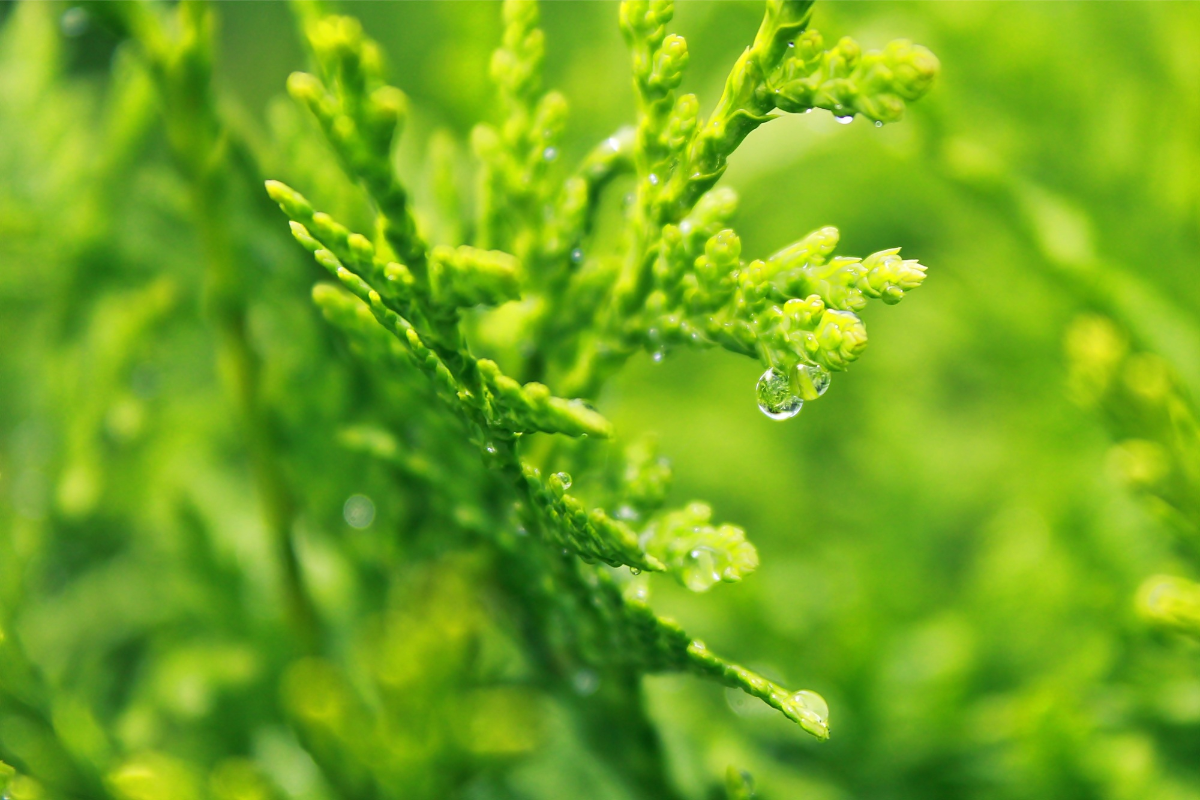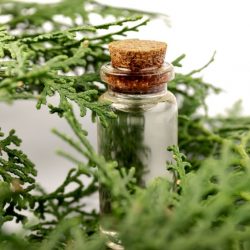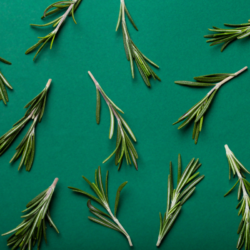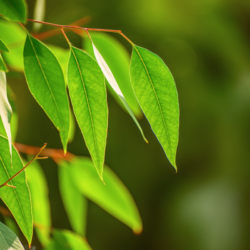Cypress essential oil, extracted from the majestic Cupressus sempervirens is a multi-faceted treasure of nature. For centuries, it has fascinated people with its unique properties and varied uses in the world of aromatherapy. In this article, we delve into the very essence of this precious oil, exploring its botanical origins, distinctive chemical components and therapeutic applications. Our journey will take us through rigorous scientific studies and ancient practices, revealing the secrets of cypress essential oil and its importance in modern alternative medicine. Whether you’re an aromatherapy enthusiast, a natural health professional, or simply curious about the wonders of phytotherapy, this article offers you a comprehensive and enlightening perspective on one of nature’s gems.
What are the characteristics of Cypress?
Cypress, whose botanical name is Cupressus sempervirens, belongs to the Cupressaceae family.
What are its botanical attributes?
Cupressus sempervirens, also known by the synonym C. Fastigiata DC, is an imposing tree. It has smooth, reddish-grey bark. Its branches and twigs are irregular, tightly packed, upright and form a long, narrow crown. Its leaves, arranged in four rows, are triangular and have a glandular shape on their dorsal surface.
The tree’s flowers are monoecious, grouped in terminal catkins. The male flowers are small and ovoid, while the females are subglobose, with around 6 to 12 scales. The cones are shiny grey-brown, subglobose and 2 to 3 cm wide. They are dehiscent, meaning they open to release their seeds. The cone scales are cross-shaped, thick, woody and evergreen. They end in a mucronate tetragonal escutcheon towards the centre. The seeds are numerous, ovoid-compressed, narrowly winged and the tree generally has 2 to 3 cotyledons.
Where does it grow?
Cypress is frequently grown in gardens and cemeteries throughout France, particularly in the southern region. Native to Eastern Europe and Western Asia, this tree flowers in April. Fruiting takes place in the autumn of the second year.
Cypresses, belonging to the genus Cupressus, are native to the warm temperate regions of the northern hemisphere. The number of species included in this genus can vary, ranging from 16 to over 31 depending on the classification. Many species of cypress are widely grown as ornamental trees.
Among these species, the common cypress occupies an emblematic place in Mediterranean flora. It is often associated with cemeteries, where it symbolises mourning in Mediterranean regions. Cypresses are conifers and can be found in a variety of locations in the major warm temperate and subtropical regions of the northern hemisphere. Their native range extends from western North America and Central America to northern Africa, the Middle East, the Himalayas, southern China and northern Vietnam.
How is Cypress essential oil used?
The essential oil is extracted by steam distillation of the leafy branches. Approximately 1 kg of cypress twigs yields 10 ml of essential oil.
How does it work?
Cypress essential oil contains a variety of compounds:
- Monoterpenes (52-77%): alpha-pinene, delta-3-carene, limonene, terpinolene
- Phenol methyl ethers (~25% ): carvacrol methyl ether
- Esters (~3%): bornyl acetate
- Sesquiterpenes (~5%)
- Sesquiterpenols (2-7%): cedrol
Cypress de Provence essential oil, rich in alpha-pinene, regulates bronchial secretion. It also stimulates the mucin glands, encouraging expectoration through coughing. Similarly, alpha-pinene has a beneficial venous decongestant action in the treatment of venous disorders accompanied by oedema.
Cypress de Provence essential oil has a notable anti-inflammatory action by inhibiting 5-lipo-oxygenase and reducing the synthesis of leukotrienes.
Cypress has an antiviral action, particularly against the HSV-1 virus. The high concentration of alpha-pinene (40 to 65%) in this essential oil makes it an effective agent against viral and bacterial infections.
Cypress de Provence essential oil is highly effective against against bacteria and fungi thanks to the presence of monoterpenes. The alpha-terpenyl acetate contained in this essential oil acts on the nervous system by targeting ion channels, helping to ease muscle spasms.
In addition to these main properties, it also has antioxidant properties.
What are its scientific indications?
Cypress essential oil has scientifically recognised activities. It has a marked effecton venous and lymphatic decongestion, helping to improve the elasticity of the veins. It is also beneficial as a vasoconstrictor.
This essential oil is highly effective as a cough suppressant, helping to relieve coughs. It also has moderate mucolytic properties, which can help liquefy mucus. As a bactericide, it is moderately effective.
Cypress de Provence essentialoil has significant spasmolytic properties, helping to ease muscle spasms.
It is particularly useful for decongesting the prostate in men and the pelvis in women, demonstrating its wide application. It has a slight oestrogen-like effect.
What are its traditional indications?
This essential oil is recommended for treating problems of venous congestion, such as haemorrhoids, varicose veins and oedema of the lower limbs.
It is beneficial for relieving prostate congestion in men and ovarian congestion in women. Cypress can be used successfully to treat infantile enuresis (nocturnal urinary incontinence).
Cypress de Provence essential oil is recommended for the treatment of spasmodic coughs and whooping cough.
It is useful for lymphatic drainage and for combating water retention and cellulite. This essential oil can be beneficial in reducing the symptoms of menopausal syndrome, particularly fluid retention.
This essential oil can also be used to combat ‘orange peel’ skin and cellulite. It is regularly used in cosmetic products to slim the figure, particularly around the buttocks, thighs and hips. It can also be effective in combating excessive perspiration.
What are its energetic indications?
- Cypress essential oil is associated with the root chakra (1, Muladhara) and the coronal chakra (7, Sahasrara) in Ayurvedic medicine.
- It encourages the development of self-confidence and facilitates decision-making. Its energy helps to anchor us more firmly in reality. It helps to avoid dispersion and wasting vital energy.
- Cypress essential oil can be used to combat seasonal depression and banish gloomy thoughts. It is also used as part of the mourning process.
How should this essential oil be used?
Given its many uses, Cypress essential oil can be taken in several ways. However, precautions must be taken when using it.
What dosage should I choose?
The health benefits and uses of Cypress essential oil are varied and cover several areas.
When applied topically, always diluted to 20%, the following uses can be distinguished:
- Excessive perspiration: directly on the armpits, hands or soles of the feet.
- Cellulite and circulation problems: massage into the legs from the bottom up.
- ENT congestion: massage the spine, back, chest and soles of the feet.
- Flu: massage along the spine and the soles of the feet.
- Allergic rhinitis, nasopharyngitis : massage along the spine and the soles of the feet.
- Sinusitis: Dilute in a vegetable oil and apply to the sinuses.
- Cough: Dilute in a vegetable oil and massage along the spine, upper back, shoulders and soles of the feet.
Diffusion and inhalation are also widely used in certain cases:
- ENT congestion and flu: by olfaction, diffusion or inhalation. Another option is to mix it in a neutral base and add it to bath water, after consulting a health professional.
- Blocked nose: By olfaction, diffusion or inhalation.
- Allergic rhinitis, nasopharyngitis: by olfaction, diffusion or inhalation.
- Sinusitis : by olfaction, diffusion or inhalation.
- Cough: by olfaction, diffusion or inhalation.
- Sick room, convalescence, epidemics: use atmospheric diffusion or olfaction by inhaling a few drops on a handkerchief.
- Psychological well-being: Use by olfaction or diffusion. You can also dilute it in a neutral base to add to bath water.
- Lack of concentration: Use Cypress essential oil by olfaction or as a vapour
It is essential to consult a health professional for certain specific applications, particularly for internal use.
What are the precautions for use?
It is essential to take certain precautions when using Cypress de Provence essential oil. You should always seek the advice of a health professional before using it if you suffer from asthma or epilepsy, as high doses can have an epileptogenic effect.
When applied to the skin, Cypress de Provence essential oil must be diluted 20% in a vegetable oil (20% essential oil and 80% vegetable oil). This dilution is necessary because this oil is rich in terpenes and can cause skin irritation.
Pregnant women may use this essential oil as a skin application, but only on medical advice. It must also be diluted.
This essential oil should only be ingested over a short period. This requires the supervision of a health professional. Prolonged use without therapeutic advice should be avoided. High doses over a long period may have nephrotoxic effects.
Atmospheric diffusion of Cypress of Provence essential oil is suitable for pregnant women and children aged 8 and over.
It should be noted that this essential oil is not recommended for people with a history of hormone-dependent cancers such as those of the breast, uterus or testicles. It is also not recommended in cases of mastosis or fibroids. The use of cypress is not recommended in cases of phlebitis and contraindications to oestrogens.
What is the ancient history of cypress?
Cypresses, these majestic trees, have survived the ages with different meanings and uses. Their thousand-year history is a fascinating tale that takes us from Antiquity to the present day, revealing beliefs, medical uses and profound symbolism.
What were Cypress trees used for in Antiquity?
In ancient times, cypress trees were used for a variety of symbolic purposes. They were often associated with the cult of the dead and the decoration of cemeteries because of their dark foliage and constant greenery, symbolising immortality. Historical evidence, such as a clay tablet from 2080 BC found in Mesopotamia, refers to the use of cypress scented oil. What’s more, these trees featured on ancient monuments dedicated to the art of healing.
What role did cypress play in ancient Egypt?
Cypress was part of the medical material used by the ancient Egyptians, as various papyri testify. Its reddish-yellow, virtually incorruptible wood was used to make sarcophagi for mummies.
In the 3rd century A.D., the Christian philosopher Origen saw cypress as the image of spiritual virtues, the good smell it gives off being that of holiness. This symbolism is not only ancient, but universal. The same beliefs can be found in China and Japan with regard to other species, the Chamaecyparis (a word that comes from the Greek and means low cypress, close to the earth) of botanists, which resemble the cypress and belong like it to the Cupressaceae family.
How did the Greeks and Romans use it?
Some 4,000 years ago, the oil extracted from its leaves and cones was used to treat all disorders of the venous system, in particular haemorrhoids, varicose veins and menopausal disorders. In the 5th century BC, Hippocrates added urinary disorders to these indications, and in the 2nd century AD, Galen added diarrhoea.
In Greece, cypress was both a medicine and a material used to honour the divinities. Pythagoras recommended it for this purpose, along with cedar, laurel, myrtle and oak.
A very old naturalized plant, it can be found on two Mediterranean islands, Crete and Cyprus, brought there by the Phoenicians. From there, it spread to Greece and Italy (with some acclimatisation difficulties, according to Pliny), then to the whole of the Mediterranean region (southern France, Spain, Morocco, Egypt, etc.), while following a path in the opposite direction towards northern India and China.
When the patient was not affected by these painful pathologies, he was ordered to go to a cypress wood so that the pulmonary patient could benefit from its healthy exhalations.
Strangely, none of the Hippocratic indications are to be found in the works of Dioscorides. He noted the diuretic virtue of cypress, which he described as a urinary remedy, as well as its action on the respiratory sphere (tightness of the chest, dyspnoea, asthma, coughs, etc.), which led him to use crushed cypress galls macerated in wine. Cypress cones were also used to treat gastrointestinal disorders. “Incorporated with wax and placed on the stomach, they fortify it”.
Much later, Serenus Sammonicus clearly departed from this therapeutic picture. He recommended cypress for bladder pain, gout and male genital disorders. More precisely, he states that cypress is effective “against nerve ruptures, pains and contractions”.
What about in the Middle East?
Before gracing the Côte d’Azur and playing a useful role as a bulwark against wind and sand, cypress took root in Asia Minor. Its presence is recorded in an old Assyrian text from the 16th century BC.
At the time of King Asir bel Nisêsu, the Assyrians and Babylonians attest to the fact that cypress had already been used for a very long time, as it was recommended for “pain and itching of the foundations”.
The Assyrians used cypress medicinally, giving it “to remedy itching of the bottom”, which we know today is one of its major uses, as an adjuvant treatment for haemorrhoids! This use was also recommended in Greek medicine by Hippocrates (4th century BC).
In Iran, according to tradition, a cane (known as a healing cane) is cut from the 3rd branch of a cypress tree, starting from the ground, to ward off disease.
In Babylon, clay tablets bearing cuneiform characters (i.e. in the shape of a “nail” or “wedge”, from the Latin cuneus) tell of the existence of cypress, which, along with willow, was one of the main plants in the Babylonian pharmacopoeia.
What did Cypress represent in Asian medicine?
In ancient China, the seeds of these conifers were said to have the power to promote longevity. Burning these same seeds helped to detect veins of gold and jade in the ground. These substances were reputed to be incorruptible, and therefore immortal. By rubbing their feet with Chamaecyparis resin, people believed they could walk on water. In Japan, where it forms magnificent mountain forests, the hinoki is a sacred tree. It is planted near temples belonging to the Shinto cult, the ancient native religion, and its wood was used to build the most venerated shrines, as well as the palace of the emperor, himself a divine figure.
How did Cypress evolve in the Middle Ages?
Its anti-haemorrhoidal properties were also mentioned in the Middle Ages in l’Arbolayre, the first herbarium printed in France in 1486.
Hildegarde only recommended cypress as a remedy for diarrhoea and to alleviate the body’s general weakness. The anti-haemorrhoidal properties of cypress reappeared in other major works of the Middle Ages: the Circa instans, theHortus sanitatis, and above all theArbolayre. An aqueous decoction of cypress leaves and cypress galls was recommended to treat flowing haemorrhoids. Adding cypress powder to food is also highly beneficial against this condition.
Cupresso plays the same role around cemeteries, protecting against wandering souls, will-o’-the-wisps and demons, as Hildegard of Bingen recounts in her Physica: “If someone is bewitched by the devil or by magic, take some of the wood at the centre of this tree, hollow it out with an auger and collect water from a living spring in an earthen vessel, passing it through the hole in the wood […]. Let this water be given to him to drink, when he is fasting, nine days in a row, because he is tormented or bewitched by the devil, by ghosts or by magic, and he will get better”. Cypress wood was therefore considered a talisman against demonic entities, since “the devil shuns with disdain everything that is virtuous, because he himself has no virtue”.
What influence do cypress trees have in modern times?
“Who doesn’t remember those Mediterranean landscapes where the dark cypresses raise their narrow, mourning columns against the violent blue of the sky? Fournier’ s fascination with cypresses may seem to us to be an integral part of the Provençal landscape. However, this host so typical of the Mare nostrum is not native to it, just as it is not indigenous to France.
If we see it here, it’s because it was brought to Western Europe and planted. Without this, Vincent Van Gogh would never have been able to produce the Arles series of cypresses. They include the famous Starry Night of May 1889. This is a scene in which a small village nestles, with the church steeple rising towards the sky, just like the massive cypress tip that occupies and shades the space on the left-hand side of the painting.
Valnet (20th century) recommended it for circulatory disorders such as varicose veins and haemorrhoids. He also recommended it for ovarian disorders such as dysmenorrhoea, menstrual bleeding and the menopause. According to him, it is also effective against infections such as whooping cough and influenza. Another use described is for sweating feet.
What beliefs and symbolism have surrounded cypress trees through the ages?
Cypress trees have survived the ages, leaving in their wake a rich heritage of beliefs and symbolism. From Antiquity to the present day, these trees have been intimately linked to the history of many civilisations, imbuing society with profound meanings.
What was the biblical role of Cypress?
Cypress has a sacred character: it is part of the biblical trilogy of sacred woods of Solomon ‘s Temple (Cedar, Cypress, Sandalwood). It was used for temples and tombs. It is defined as a symbol of death and resurrection, immortality, transcendence, regenerative “fire”, imputrescibility and incorruptibility.
Cypress was used for the coffins of dignitaries in many ancient societies. Popes’ coffins follow this tradition: John Paul II was no exception when he died in 2005.
What role did cypresses play in Greek and Roman mythology?
In Greece, there were a number of sacred groves of cypress trees near temples dedicated to various deities: Apollo, Hermes, Rhea, Laïs, Bellerophon, Asclepius, etc.
But the cypress is best known as a symbol of the infernal or ‘dark’ deities. Chronos or Beroth, the Cypriot chthonic goddess, are sometimes cited. But it is invariably Hades among the Greeks, Pluto among the Romans, whose priests are crowned with cypress branches.
The poets deliberately render the places occupied by this divinity of the underworld as sinister: “It is a chaos, they are rocks bristling with pumice stone, which love only the gloomy cypress standing all around. It was in the midst of this abode that Pluto raised his head, marked by the flames and white ashes of the pyres”.
Ovid attributes this coniferous tree to Kyparissos, who, inconsolable at having inadvertently killed a deer, transformed himself into a cypress. This young Cretan lived with a tame deer, which he inadvertently wounded with a javelin. Inconsolable at the animal’s death, and wanting to die himself, he was transformed into a cypress. Apollo said to the man who had become a tree: “I will weep for you always, and you will weep for others and share their pain”. This man must certainly have been a tree-god. His sacred animal, the stag, is the symbol of the perpetual rebirth of life. Bringing together, in a single myth, a plant emblem and another animal, both with identical semantic significance, was a way of reflecting the fact that while the cypress embodies the idea of mortality and finitude, it is also a bearer of immortality.
Similarly, the poet Horace saw the cypress as having “the double role of generation and death”. For him, as for Seneca, it can be nothing other than a sad tree. He knows and does not accept that the cypress will necessarily outlive him. Virgil was not far from thinking the same, but without injecting as much bad humour into his words as the author of the Odes, who died aged less than 57.
What beliefs linked Ancient Egypt to Cypress trees?
These medical indications should not obscure the sacred nature of cypress for many civilisations. For example, the fact that in Egypt it was one of the ritual ingredients in kyphi tells us something about this dimension.
If cypress is described as thetree of life, it is because of its durability and its obvious semper virens nature. It has the persistence and durability to be evergreen. Its wood is also rot-proof. In fact, it contains a resin that makes it impervious to vermin. That’s why the Egyptians, horrified by worms, carved sarcophagi from cypress wood. Later, the coffins of the dignitaries of many ancient societies followed this example. Like all phallic trees, the cypress is a symbol of generation, death and the immortal soul.
What were the links between the beliefs of the Persian Empire, the Chinese Empire and Cypress trees?
In Persia, the cypress tree was considered to be the primitive tree of paradise for the ancient Iranians. This tree was attributed to a divinity such as Ormuzd, who was on the contrary a solar god. The latter “saw in the shape of the cypress, whose sharp point rises towards the sky, the vegetable representative of the generating fire […]; this is why it was found in front of all the temples dedicated to fire, in the courtyard of the royal palace, and at the very centre of the pleasure gardens which were supposed to reproduce, albeit faintly, the memory of the lost paradise”.
The nearly 4,500-year-old Zoroaster cypress at Abarkouh in Iran bears witness to this. It forces us to remember that in the time of the prophets, these remarkable cypress trees were worshipped. Such trees were then “the most august and general emblem of the female divinity in the dual role of generation and death”.
By virtue of its verticality and its solid anchorage in the earth, for the Chinese it represented the bridge that united Heaven and Earth. This is why its essential oil is used particularly as a transition and separation agent. Cypress essential oil is used to ease the pain of people who are too focused on their past or unable to project themselves forward without fear.
References:
- https://www.ncbi.nlm.nih.gov/pmc/articles/PMC4052795/
- https://www.ncbi.nlm.nih.gov/pmc/articles/PMC4052795/
- https://www.researchgate.net/publication/236784045
- https://ijbms.mums.ac.ir/article_5165_fd728cb47f4aa5d4a65d2a9b74eb1704.pdf
- https://www.ncbi.nlm.nih.gov/pmc/articles/PMC5435909/
- https://www.ncbi.nlm.nih.gov/pmc/articles/PMC5435909/
- https://www.ncbi.nlm.nih.gov/pmc/articles/PMC1142199/





